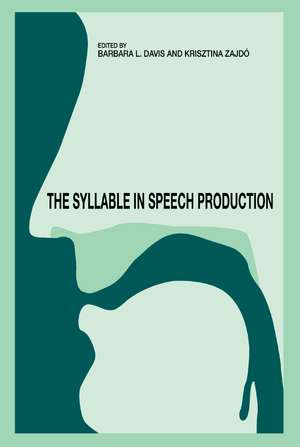The Syllable in Speech Production: Perspectives on the Frame Content Theory
Editat de Barbara L. Davis, Krisztina Zajdoen Limba Engleză Paperback – 8 feb 2008
Chapters are arranged around five thematic areas. Two themes, Evolutionary Perspectives on Speech Production and Acquisition of Speech, reflect the major thrust of Peter’s scholarly career over the past 25 years. The other themes are reflective of the broad implications of MacNeilage’s work for scholars in disparate scientific domains. One of the strengths of this volume is the unitary focus of contributions by scientists from diverse scientific backgrounds in considering the applicability of the Frame Content Theory within their own scholarly perspectives. Thematic strands in the volume include:
- - Evolutionary Perspectives on Speech Production
- - Neurobiological Aspects of Speech
- - Perception / Action Relationships
- - Acquisition of Speech Production Skill
- - Modeling and Movement
- - Alternative Perspectives on the Syllable.
Preț: 572.59 lei
Preț vechi: 765.52 lei
-25% Nou
Puncte Express: 859
Preț estimativ în valută:
109.57€ • 117.16$ • 91.35£
109.57€ • 117.16$ • 91.35£
Comandă specială
Livrare economică 27 martie-10 aprilie
Doresc să fiu notificat când acest titlu va fi disponibil:
Se trimite...
Preluare comenzi: 021 569.72.76
Specificații
ISBN-13: 9780805854800
ISBN-10: 0805854800
Pagini: 480
Dimensiuni: 152 x 229 x 25 mm
Greutate: 0.64 kg
Ediția:1
Editura: Taylor & Francis
Colecția Taylor & Francis
Locul publicării:Oxford, United Kingdom
ISBN-10: 0805854800
Pagini: 480
Dimensiuni: 152 x 229 x 25 mm
Greutate: 0.64 kg
Ediția:1
Editura: Taylor & Francis
Colecția Taylor & Francis
Locul publicării:Oxford, United Kingdom
Cuprins
B. Lindblom, Foreword. B.L. Davis, K. Zajdo, Introduction. P.F. MacNeilage, The Frame/Content Theory. Section 1. Evolutionary Perspectives. D. Kimbrough Oller, U. Griebel, The Origins of Syllabification in Human Infancy and in Human Evolution. L.-J. Boë, P. Bessière, N. Ladjili, N. Audibert, Simple Combinatorial Considerations Challenge Ruhlen’s Mother Tongue Theory. D. Demolin, The Frame/Content Theory and the Emergence of Consonants. J.L. Locke, Lipsmacking and Babbling: Syllables, Sociality, and Survival. Section 2. Neurobiological Aspects. L. Fogassi, P. Francesco Ferrari, Mirror Neurons and Evolution of Communication and Language. N.O. Schiller, Syllables in Psycholinguistic Theory: Now You See Them, Now You Don’t. Section 3. Perception/Action Relationships. J.J. Ohala, The Emergent Syllable. K. Schauwers, P.J. Govaerts, S. Gillis, Co-occurrence Patterns in the Babbling of Children with a Cochlear Implant. J.A. Moore, The Development of Consonant Vowel Syllables in Children Following Cochlear Implantation. F.J. van Beinum, Frames and Babbling in Hearing and Deaf Infants. Section 4. Acquisition of Speech. J.M. van der Stelt, Teething, Chewing, and the Babbled Syllable. C. Matyear, An Acoustical Analysis of Consonant-Vowel Co-occurrences in Babbling: Coronal and Dorsal Contexts. C. Stoel-Gammon, B. Peter, Syllables, Segments, and Sequences: Phonological Patterns in the Words of Young Children Acquiring American English. Section 5. Modeling and Movement. B. Lindblom, The Target Hypothesis, Dynamic Specification and Segmental Independence. M.A. Redford, P. van Donkelaar, Jaw Cycles and Linguistic Syllables in Adult English. Section 6. Alternative Perspectives on the Syllable. W. Sadler, The Syllable in Sign Language: Considering the Other Natural Language Modality. C. Abry, V. Ducey, A. Vilain, C. Lalevée, When the Babble-Syllable Feeds the Foot.
